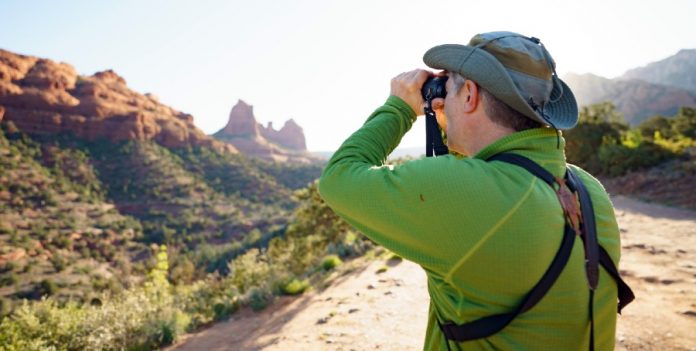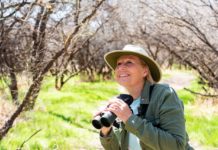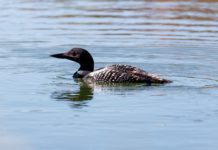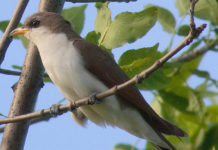
While a lot of human travel has paused temporarily, that has not slowed down the planet’s birds, which are on the move across oceans and continents as winter turns to spring in the northern hemisphere. Birders in the Verde Valley look forward to this time because it’s the prime season to observe birds and add to yearly or geographic bird lists.
“Winter is a good time [to bird watch], fall is a decent time, spring is the best time,” Rich Armstrong, field trip leader for the Northern Arizona Audubon Society, said.
“All of these birds that winter in Mexico and further points south are coming north, by the millions — actually probably more like the billions — so there are a lot more birds [in the Verde Valley] now than there were a few weeks ago,” Armstrong said. “Now granted, some of the winter birds are leaving, so that reduces things, but when you get to May 1, most of the summer birds are back and a lot of migrants are moving. It’s an exciting time for bird watching.”
Through word-of-mouth and birding websites like Cornell University’s eBird.org, Sedona bird watchers gain a heightened awareness of the avian life moving in and out of the region this time of year.
Armstrong gave a quick report of birds that have recently returned to the area from their winter territories — information which is changing daily.
“Black-chinned hummingbirds are back. Lucy’s warblers are back. Common blackhawks are back. Newer birds like Scott’s orioles or Hooded orioles are arriving now. Yellow warblers are arriving now, and other birds like summer tanagers and flycatchers will arrive later in April,” Armstrong said.
“If you haven’t had feeders out all winter,” Armstrong added, “you want to get them out there now, because birds are coming.”
Among the birds making cameo appearances in the Verde Valley this time of year are sea and shore birds that appear exotic in the desert. Armstrong gave the example of a flock of colorful avocets — long-legged wading birds that nest as far north as Canada — that stopped at the city’s Sedona Wetlands Preserve recently.
This week Sedona birder Sam Hough photographed a common loon at the preserve. That bird can be seen on eBird.org.
For Armstrong, these migrant birds passing through the Verde Valley for just a day or two are among the most exciting to spot.
Tim Weber, owner of Sedona-based guide service Birding Northern Arizona, said that the unpredictability of which birds will make an appearance is one of the things that makes birding so exciting this time of year.
“Especially for the next two months, new birds are showing up everyday,” he said. “Some are just stopping in for a moment and continuing north and others are going to stay here, so you can get surprised just every time you go out birding.”
Armstrong said that when birds arrive in Sedona from their winter havens, they are eager to start staking out a territory, mating and nesting, so they begin singing in earnest at sunrise each morning.
Adding to the growing chorus are Sedona’s permanent residents, like Gambel’s quail and Woodhouse’s scrub-jays, which become more vocal than normal as they also begin mating and nest-building.
“As we get more into the breeding season, you get what’s called the ‘dawn chorus.’ …First thing in the morning birds are hungry, they get up and they start to sing while foraging, and so there’s a lot going on — establishing the territory, getting the mate,” Weber said while catching measures of birdsong along the Munds Wagon trail on April 3. “In another month you come at sunrise and it’s just every single bird is singing, and it’s pretty neat to behold. We’re getting there — there’s a few birds singing away.”
During a quarter-mile walk from the trailhead, Weber identified at least a dozen bird species, including spotted Townsend’s solitaire, Spotted towhee, Black-chinned sparrow, Anna’s hummingbird and Black-throated swifts, among many others.
“The way I bird in general is listen first and kind of head in the direction of those sounds,” he said.
Weber has a background in wildlife management and conducting bird surveys, so he has had to learn a lot of different bird calls.
And he doesn’t just identify birds as he walks, but gives insight into what each bird is doing at that moment among the desert plants, or in the case of the black-throated swifts, while perched upon a red rock citadel high above.
A large number of the birds that morning could be seen on the tops of trees or tips of branches, with their chests puffed out and blasting songs out into the world.
According to Weber, this is a distinctly spring behavior.
“They tend to take a few more chances in the breeding season. Basically the life and the day of the songbird is to try to stay alive and not be eaten by a hawk. Every time he’s on the top of a tree, he’s putting himself at risk that a Cooper’s hawk might come by and try to eat him,” Weber said. “He’s establishing this territory and hopefully a female is listening. Or he may have already found the female, and he’s still got the hormones flowing to keep singing and say ‘this is my territory, don’t come in and bother me on it.’”
The coronavirus pandemic has canceled spring field trips and classes sponsored by the Northern Arizona Audubon Society, but local birders continue to log dozens of bird sightings everyday on eBird.org. In just one recent day, Yavapai County birders recorded 120 sightings in backyards, neighborhoods and important birding sites like the Sedona Wetlands.
Weber has had to suspend his birding tours — a blow, since 75% of his business is during the spring — but he is still going out every other day birding. When the dawn chorus starts, Weber said he’ll be out everyday.
While birding with Weber off Schnebly Hill Road, the activity feels like an exercise in expanding awareness of what is happening in the surroundings — almost like a mindfulness exercise. The reward of paying attention is that a lot of drama emerges in a relatively small space.
“It’s funny with bird watching, you normally don’t get as far as you want unless you just put the binoculars down and say ‘OK, we’re not going to birdwatch for a little bit,’” Weber said. “Almost all my tours, we rarely get a mile from the car.”
Weber said to start birdwatching, “all you need is a pair of binoculars and a will to get up a little earlier.” He recommends investing in a good pair of binoculars — something over $200 is worthwhile if you can afford it, he said.
Armstrong suggested that new birdwatchers get started by looking at websites like eBird.org and their local Audobon Society website to familiarize themselves with the types of birds in the area and the types of feeders that attract those birds.
“One of the things you might do is birdwatch in your yard. You can go to northernarizonaaudobon.org. That’s the website of your local Audobon society. There’s a ton of information on there,” Armstrong said.





















